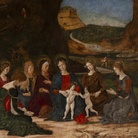Other Home

Enkhbold Togmidshiirev, Unen Enkh, Other Home, 2015. La Biennale di Venezia, Padiglione Mongolia
From 09 Maggio 2015 to 22 Novembre 2015
Venice
Place: Biennale Palazzo Mora / Pav. Mongolia
Address: Strada Nuova, 3659 Venezia
Responsibles: Uranchimeg Tsultemin
Official site: http://mongolia-pavilion-venice-biennale.com
The Mongolia Pavilion explores modern-day mobility and displacement, raising questions about what and where “home” is and humans’ relationship with nature. The artists work with natural organic products from Mongolian nomadic traditions, such as felt, horsehair, horse dung, and wood. The Mongolia Pavilion consists of two types of art presentation: a sedentary pavilion space at the Palazzo Mora and a nomadic pavilion with artist Enkhbold’s performances presented at designated public spaces around the city of Venice.
The two artists were born and raised in Mongolia and experienced migration as young adults. Artist Unen Enkh attended art schools in Prague and Budapest and later moved to the German city of Freiburg im Breisgau, where he completely transformed his art from two-dimensional graphic media to sculptures made with natural materials from his homeland.
Enkhbold’s art includes a variety of media. His two-dimensional works, made primarily of horse dung, ash, sand, and wood, will be displayed at the Palazzo Mora. With these works, Enkhbold joins the artists who defy the traditional concept of painting and its usual materials. Enkhbold’s performance art in Venice further develops ideas that he has explored previously at different locales around the world. Enkhbold questions the division between urban forms and his nature-based ger (yurt).
Venice was built by residents fleeing invasions by nomads, including Attila and the Huns in the 5th century. Centuries later, Venetian merchant Marco Polo (1254–1324) traveled to the Mongol Empire, where he spent 16 years at the Mongol Khan’s court. Enkhbold, building upon the historical legacy of Venice’s relationship with nomads and Mongols, will bring his performance art to the heart of Venice by nomadizing around the city and socializing with Venice locals and visitors.
The Mongolia Pavilion is funded by leading Mongolian businesses and supported by Bat-Uul. Mayor of Ulaanbaatar.
The two artists were born and raised in Mongolia and experienced migration as young adults. Artist Unen Enkh attended art schools in Prague and Budapest and later moved to the German city of Freiburg im Breisgau, where he completely transformed his art from two-dimensional graphic media to sculptures made with natural materials from his homeland.
Enkhbold’s art includes a variety of media. His two-dimensional works, made primarily of horse dung, ash, sand, and wood, will be displayed at the Palazzo Mora. With these works, Enkhbold joins the artists who defy the traditional concept of painting and its usual materials. Enkhbold’s performance art in Venice further develops ideas that he has explored previously at different locales around the world. Enkhbold questions the division between urban forms and his nature-based ger (yurt).
Venice was built by residents fleeing invasions by nomads, including Attila and the Huns in the 5th century. Centuries later, Venetian merchant Marco Polo (1254–1324) traveled to the Mongol Empire, where he spent 16 years at the Mongol Khan’s court. Enkhbold, building upon the historical legacy of Venice’s relationship with nomads and Mongols, will bring his performance art to the heart of Venice by nomadizing around the city and socializing with Venice locals and visitors.
The Mongolia Pavilion is funded by leading Mongolian businesses and supported by Bat-Uul. Mayor of Ulaanbaatar.
SCARICA IL COMUNICATO IN PDF
enkhbold togmidshiirev ·
unen enkh ·
enkhbold togmidshiirev unen enkh ·
other home ·
mongolia pavillion
COMMENTI

-
 Dal 20 dicembre 2024 al 04 maggio 2025
Fermo | Palazzo dei Priori
Dal 20 dicembre 2024 al 04 maggio 2025
Fermo | Palazzo dei Priori
-
 Dal 20 dicembre 2024 al 04 maggio 2024
Gorizia | Palazzo Attems Petzenstein
Dal 20 dicembre 2024 al 04 maggio 2024
Gorizia | Palazzo Attems Petzenstein
-
 Dal 18 dicembre 2024 al 18 dicembre 2024
Venezia | Museo Correr
Dal 18 dicembre 2024 al 18 dicembre 2024
Venezia | Museo Correr
-
 Dal 14 dicembre 2024 al 02 marzo 2025
Palermo | Palazzo Abatellis
Dal 14 dicembre 2024 al 02 marzo 2025
Palermo | Palazzo Abatellis
-
 Dal 12 dicembre 2024 al 23 febbraio 2025
Roma | Palazzo Altemps
Dal 12 dicembre 2024 al 23 febbraio 2025
Roma | Palazzo Altemps
-
 Dal 13 dicembre 2024 al 31 agosto 2025
Roma | Museo dell'Ara Pacis
Dal 13 dicembre 2024 al 31 agosto 2025
Roma | Museo dell'Ara Pacis


